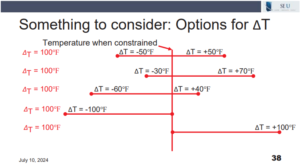Common Errors in Determining Temperature Effects in Steel Structures
Are you considering thermal effects in the steel structures you design? A building which is exposed to the elements might be an obvious example of a structure that will experience thermal changes, but are there other structures that should be investigated for possible thermal self-straining forces? How do engineers predict these forces and what does the building code require to prevent harmful effects from temperature changes?
In the July 2024 SEU Session, Barry Arnold, PE, SE, retired VP from ARW Engineers, presented Temperature Effects in Steel Structures. Barry identified code requirements for thermal forces and applicable equations and explained some common errors in the application of thermal forces. Barry also pointed out some possible consequences of ignoring thermal forces in steel structures, and showed where and how thermal forces manifest themselves.
ASCE addresses thermal, or self-straining, forces in Section 2.3.4 and states that “Where the structural effects of T [ΔT] are expected to adversely affect structural safety or performance T [ΔT] shall be considered in combinations with other loads…” ASCE further addresses thermal forces in the Commentary in Section C6.3 and notes that structures will experience thermal distortions which are significant when exposed to “ambient temperature variations,” thus, engineers will need to define this variation on their structure. Barry suggested the use of the word “ambient” may lead to a common error in determining the possible thermal changes during the life of the structure, To hear Barry explain how complicated this issue can be, watch this short video:
While there are many factors to consider when determining ΔT, Barry showed his method for approximating ΔT. As you can see in the following slide, Barry uses a ΔT of 100 degrees while considering the temperature of the steel when constrained and the geographic location and building type.
This method offers a good starting point, however, as AISC’s Manual of Steel Construction notes in L6 of the commentary, “The satisfactory accommodation of thermal expansion and contraction cannot be reduced to a few simple rules, but must depend largely upon the judgment of a qualified engineer.” Thermal forces can cause a variety of issues in steel structures, and a qualified engineer should consider the many variables which can affect these forces within the structure.




There are no comments yet, but you can be the first